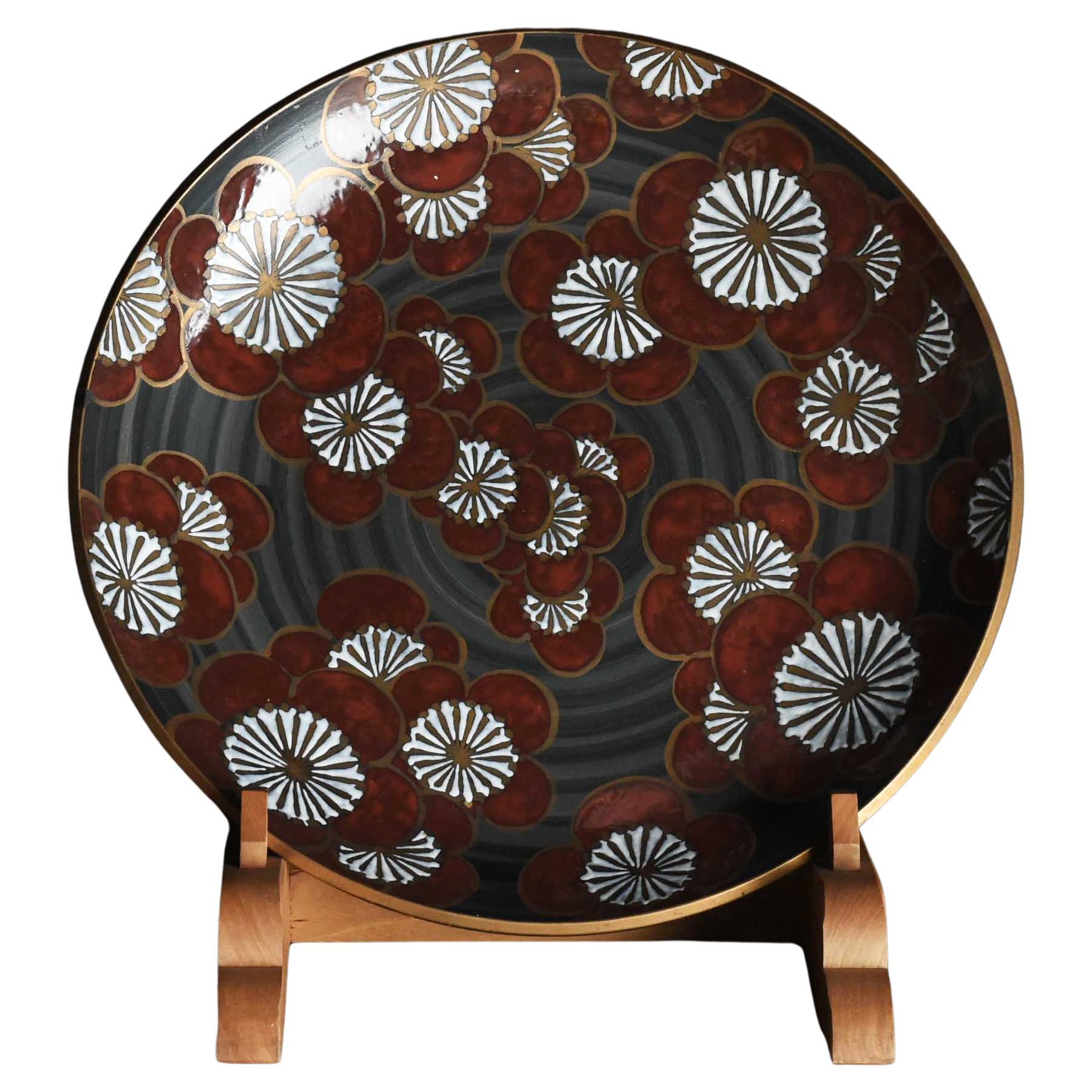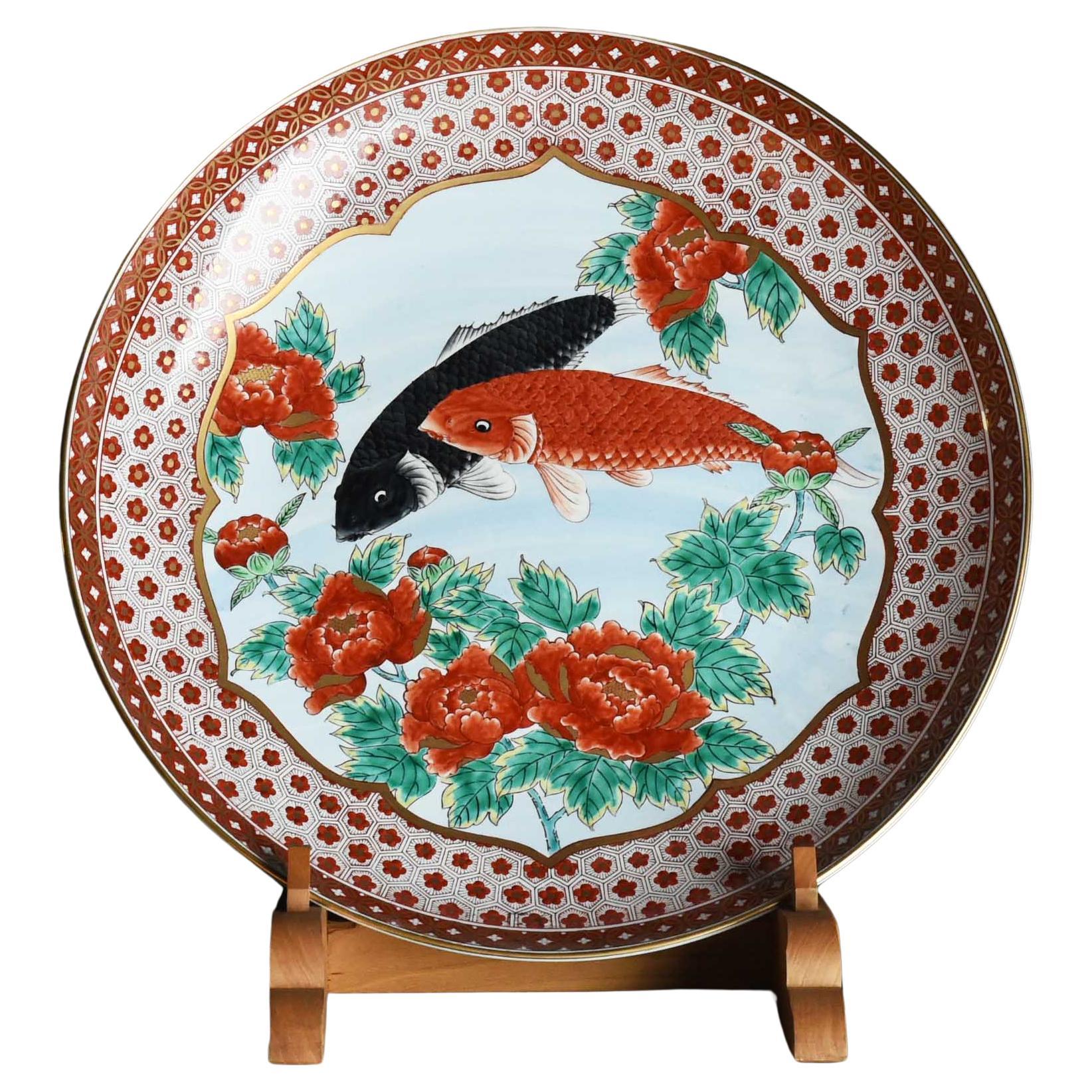Items Similar to Japanese Arita "Kinrante Houou 30 Gou" Handmade large plate
Want more images or videos?
Request additional images or videos from the seller
1 of 7
Japanese Arita "Kinrante Houou 30 Gou" Handmade large plate
About the Item
Hand-drawn. The phoenix is a symbol of peace and happiness, and is considered auspicious.
Kinran-de is a technique that originated during the prosperous Genroku period of the Edo era in Japan. Its name derives from the similarity of its luxurious color scheme to that of kinran, a type of brocade fabric. This technique involves applying gold patterns to white porcelain that has been decorated with colored glaze, using rich colors such as red and gold to create lavish designs. The process involves multiple firings, with each color requiring a separate firing, and the use of gold making it one of the most challenging styles in the world of ceramics, requiring significant time and effort.
- Similar to:Arita (Artist)
- Dimensions:Height: 6.7 in (17 cm)Diameter: 36.62 in (93 cm)
- Style:Japonisme (In the Style Of)
- Materials and Techniques:
- Place of Origin:
- Period:
- Date of Manufacture:1950-1960s
- Condition:
- Seller Location:Shibuya City, JP
- Reference Number:1stDibs: LU9752239840132
About the Seller
New to 1stDibs
Joined in the past six months.
No Reviews Yet
Vetted Seller
These experienced sellers undergo a comprehensive evaluation by our team of in-house experts.
1stDibs seller since 2024
- ShippingRetrieving quote...Ships From: Shibuya City, Japan
- Return PolicyA return for this item may be initiated within 14 days of delivery.
More From This SellerView All
- Japanese Arita "Gokujou Madorikachou 18 Gou" handmade large plateBy AritaLocated in Shibuya City, JPUsing a technique called "dami-e," the artist applies a heavy pigment to a large brush and paints onto the fabric, allowing the pigment to soak into the material as they work.Category
Mid-20th Century Japanese Japonisme Ceramics
MaterialsCeramic, Porcelain
- Japanese Arita "Fuchijimon Kujaku 20 Gou" Handmade large plateBy AritaLocated in Shibuya City, JPHand-drawn. Peacocks are used to symbolize disaster avoidance and prosperity for descendants, making them a perfect subject for the world of decorative beauty. These dishes, rich in ...Category
Mid-20th Century Japanese Japonisme Ceramics
MaterialsCeramic, Porcelain
- Japanese Arita "Akadamiume 15 Gou" Handmade ornamental plateBy AritaLocated in Shibuya City, JPHand-drawn. The plum blossom is a motif that symbolizes patience, vitality, and the celebration of the New Year.Category
Antique Mid-19th Century Japanese Japonisme Ceramics
MaterialsCeramic, Porcelain
- Japanese Arita "Kinrante Houou" Handmade ornamental vaseBy AritaLocated in Shibuya City, JPHand-drawn. The phoenix is a symbol of peace and happiness, and is considered auspicious. Kinran-de is a technique that originated during the prosperous Genroku period of the Edo er...Category
Mid-20th Century Japanese Japonisme Porcelain
MaterialsCeramic, Porcelain
- Japanese Arita "Koie" Handmade large plateBy AritaLocated in Shibuya City, JPHand-drawn. Decorative plates incorporate traditional designs that reflect the changing seasons. While staying true to tradition, new expressions suitable for the times are sought, a...Category
Mid-20th Century Japanese Japonisme Ceramics
MaterialsCeramic, Porcelain
- Japanese Arita "Somenishiki Madori Houou" ornamental vase with lidBy AritaLocated in Shibuya City, JPThis artwork is hand-painted and depicts a phoenix, a symbol of peace and happiness that is considered auspicious. The technique used is called sometsuke, which involves applying gla...Category
Mid-20th Century Japanese Japonisme Ceramics
MaterialsCeramic
You May Also Like
- Large 17th Century Japanese Arita BowlBy AritaLocated in Christchurch, GBAs part of our Japanese works of art collection we are delighted to offer this large and most charming Edo Period (1615-1868), ceramic fruit bowl manufactured during the late 17th ce...Category
Antique 17th Century Japanese Edo Ceramics
MaterialsCeramic
- Massive Antique Japanese Arita Porcelain Emperor MeijiBy AritaLocated in Hillringsberg, SEThis very large plate made in Japan during the Emperor Meiji time 1868-1912. Wonderful blue pattern on fine porcelain. There is a crack that’s shown thro...Category
Antique 19th Century Japanese Japonisme Ceramics
MaterialsCeramic
- Japanese Antique Kakiemon Plate from AritaLocated in Atlanta, GAA milky white dish with slight scalloped rim and decorated with cobalt blue iron red and green enamel over glaze, this delicate piece in Kakiemon Style was dated at least to the earl...Category
Antique Early 18th Century Japanese Japonisme Ceramics
MaterialsPorcelain
- Japanese Imari charger of large size, Arita, c. 1700, Genroku Period.By AritaLocated in Gargrave, North YorkshireA large Japanese Imari deep charger, Arita, c. 1700, Genroku Period. Hand painted to the centre, with a large vase containing a profusion of flowers, upon a terrace. The broad border...Category
Antique 17th Century Japanese Edo Ceramics
MaterialsPorcelain
- Massive Japanese Arita Presentation Porcelain Plate Meiji PeriodLocated in Atlanta, GAThis massive Japanese Arita plate was made in Hizen, circa 1890-1910s, at the end of Meiji period by a potter named Takeshige Yoshisuke who was active in A...Category
Antique Late 19th Century Japanese Japonisme Ceramics
- A Massive Antique Japanese Arita Porcelain Plate by Kajiwara KilnLocated in Atlanta, GAOn offer is a truly impressive blue and white porcelain plate of Hizen ware, from Arita in Japan, circa mid to late-19th century. The plate was made by Kajiwara Kikujiro (菊次郎, the second Kiku son) and/or Kajiwara Kikusaburo (菊三郎, the third Kiku son who died in 1883) of the Kajiware Family Kiln of in Arita. It was decorated in a superb design with blue under-glaze, clearly out of a hand of a master. In a Classic Japanese composition that was popular in the Meiji Period, the plate displays a riot of auspicious elements, arranged still in a surprisingly harmonious manner. Anchoring the center of the design is an eagle perched on the branch of a blooming cherry tree, its talons clenching the bark and its wings about to open. The motion of the its immediate taking off is palpable. The trunk and the branches of the old cherry tree provide a spacial frame for the arrangement of large peonies with foliage, bundles of chrysanthemums, Chinese bell...Category
Antique 19th Century Japanese Japonisme Ceramics
MaterialsCeramic
Recently Viewed
View AllMore Ways To Browse
Antique Ceramic Symbols
Arita Porcelain Plate
Antique Brocade Fabric
Asian Phoenix
Arita Plate
Large Asian Plate
Large Japanese Porcelain Plates
1960s Asian Style Furniture
Blue And White Asian Vase
Floral Japan Porcelain
Meiji Arita
Pair Of Antique Asian Vases
Chinese Porcelain Dragon
19th Chinese Famille
Qianlong China
Chinese Qianlong
Porcelain Roses
Qing Dynasty Chinese Export Furniture





